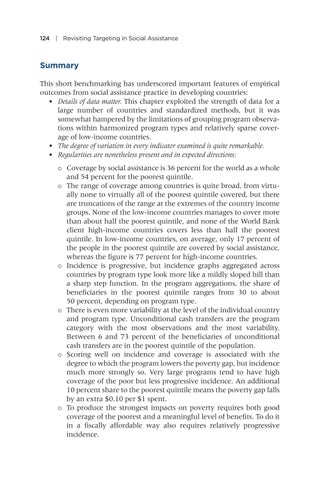124 | Revisiting Targeting in Social Assistance
Summary This short benchmarking has underscored important features of empirical outcomes from social assistance practice in developing countries: • Details of data matter. This chapter exploited the strength of data for a large number of countries and standardized methods, but it was somewhat hampered by the limitations of grouping program observations within harmonized program types and relatively sparse coverage of low-income countries. • The degree of variation in every indicator examined is quite remarkable. • Regularities are nonetheless present and in expected directions: Coverage by social assistance is 36 percent for the world as a whole and 54 percent for the poorest quintile. °° The range of coverage among countries is quite broad, from virtually none to virtually all of the poorest quintile covered, but there are truncations of the range at the extremes of the country income groups. None of the low-income countries manages to cover more than about half the poorest quintile, and none of the World Bank client high-income countries covers less than half the poorest quintile. In low-income countries, on average, only 17 percent of the people in the poorest quintile are covered by social assistance, whereas the figure is 77 percent for high-income countries. °° Incidence is progressive, but incidence graphs aggregated across countries by program type look more like a mildly sloped hill than a sharp step function. In the program aggregations, the share of beneficiaries in the poorest quintile ranges from 30 to about 50 percent, depending on program type. °° There is even more variability at the level of the individual country and program type. Unconditional cash transfers are the program category with the most observations and the most variability. Between 6 and 73 percent of the beneficiaries of unconditional cash transfers are in the poorest quintile of the population. °° Scoring well on incidence and coverage is associated with the degree to which the program lowers the poverty gap, but incidence much more strongly so. Very large programs tend to have high coverage of the poor but less progressive incidence. An additional 10 percent share to the poorest quintile means the poverty gap falls by an extra $0.10 per $1 spent. °° To produce the strongest impacts on poverty requires both good coverage of the poorest and a meaningful level of benefits. To do it in a fiscally affordable way also requires relatively progressive incidence. °°
